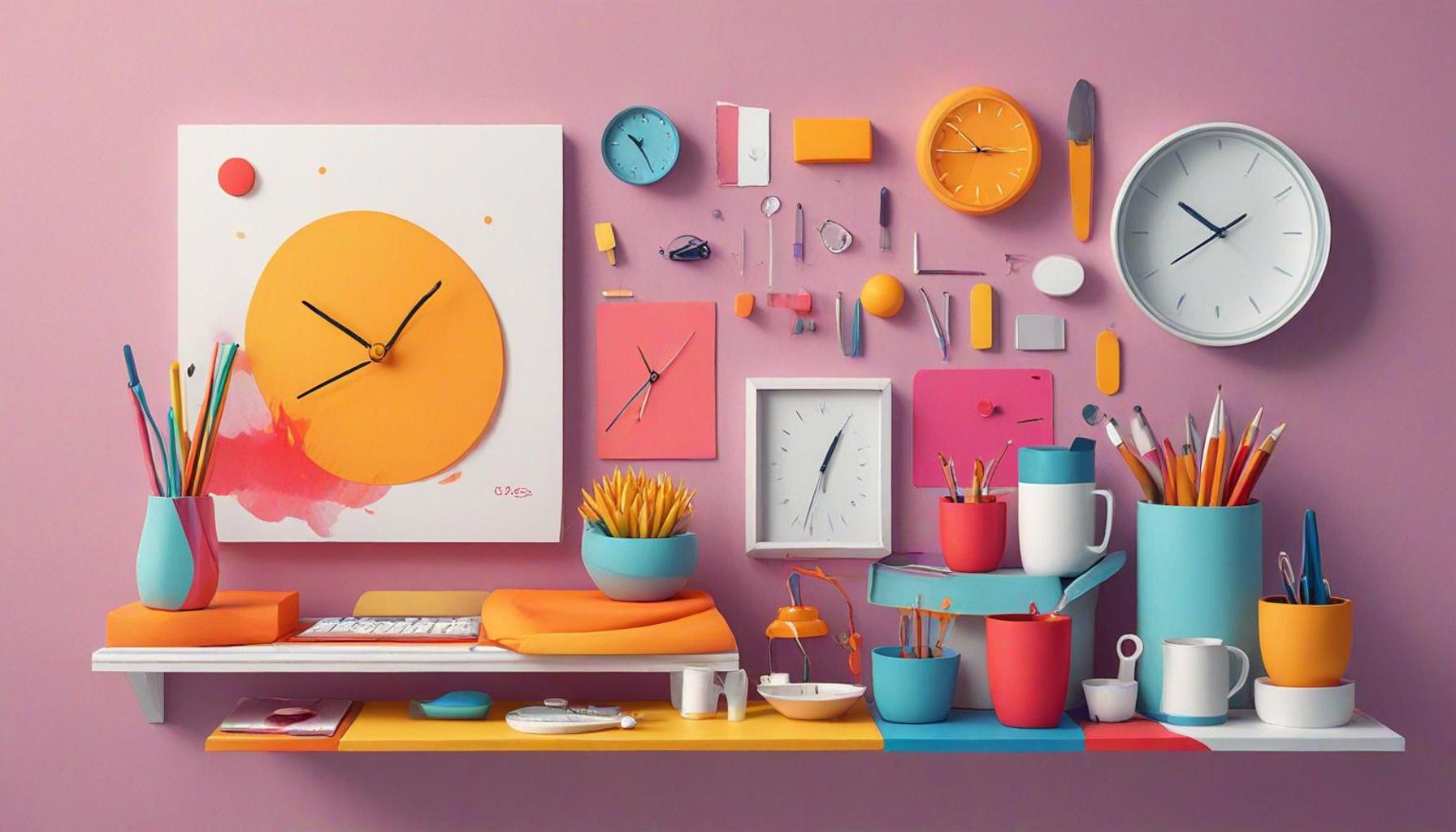Intentional Design as a Tool for Self-Knowledge and Personal Growth in Minimalism

Harnessing Intentional Design
In an era characterized by overwhelming choices and incessant distractions, the practice of intentional design stands out as a pivotal method for cultivating self-knowledge and igniting personal growth. By honing in on what genuinely matters, individuals can navigate the often chaotic complexities of life with enhanced clarity and purpose. Minimalism, while typically perceived as a lifestyle choice focused on owning fewer possessions, forms the cornerstone of this significant journey towards intentional living.
- Focus on Essentials: Intentional design advocates for the elimination of distractions and encourages prioritization of elements that resonate with one’s core values. For instance, consider the popular trend of decluttering, as exemplified by Marie Kondo’s teachings. Her approach encourages people to ask themselves whether their possessions “spark joy,” which serves as a practical methodology for evaluating the relevance and resonance of items in one’s life.
- Enhances Self-Awareness: This transformative philosophy invites deep introspection, compelling individuals to examine not just their physical belongings, but also their habits and relationships. By reflecting on what adds value to their lives, individuals can identify toxic relationships and unproductive routines, paving the way for healthier connections and habits that nurture their well-being.
- Creates Mental Clarity: Adopting a minimalist approach significantly reduces clutter, not only in physical spaces but also within the mind. This reduction fosters a serene mental state, allowing for improved focus and productivity. Research suggests that environments with less clutter can enhance cognitive functioning, making it easier for people to concentrate on their tasks and goals.
This philosophy of intentional design extends well beyond physical space, encompassing emotional and digital clutter as well. With the surge of digital devices in everyday life, the concept of digital minimalism has gained traction. Individuals are now encouraged to critically evaluate the impact of screens, social media, and constant notifications on their mental health. By reducing digital interference, one may reclaim valuable time and foster deeper connections with others.
As we delve deeper into the components that define intentional design and its symbiotic relationship with minimalism, we uncover its profound implications on personal growth. Studies show that individuals who actively practice intentionality report higher levels of life satisfaction and emotional resilience. By reassessing priorities and streamlining daily choices, people can experience a newfound sense of purpose.
Join us in this exploration as we uncover practical strategies to cultivate an intentional life. Discover how making deliberate choices can illuminate pathways to not just a simpler, but a more fulfilling existence.
DIVE DEEPER: Click here to enhance your personal organization
Understanding the Principles of Intentional Design
The essence of intentional design as a tool for self-knowledge and growth lies in its ability to provoke reflection and transformation. By applying the principles of minimalism not just to our possessions but to every aspect of our lives, we create a framework for enhancing our understanding of ourselves and what we value most. This journey into intentional living requires conscious decisions aimed at crafting a life that aligns with our innermost beliefs and aspirations.
The relationship between intentional design and minimalism can be deeply empowering. Here are several key components to consider:
- Purposeful Simplification: Begin with a thorough evaluation of your life. What activities, commitments, and materials reflect your true self? Engage in a purposeful simplification process where the aim is not solely to reduce but to enhance. For example, individuals might purge their schedules by eliminating non-essential obligations that drain time and energy, thereby creating space for pursuits that genuinely resonate with their identity.
- Value-Centric Choices: Implementing intentional design means making choices that prioritize your values. Consider adopting a framework that encourages quarterly reflections on how your daily actions align with your long-term goals. Whether it’s a commitment to health, family, or career, aligning choices with core values fosters authenticity and satisfaction.
- Mindful Consumption: In a consumer-driven culture, distinguishing between wants and needs is crucial. Mindful consumption encourages individuals to scrutinize their purchasing decisions, recognizing that each item or relationship we invite into our lives can either elevate or detract from our intended atmosphere of peace and clarity. This can apply not only to physical items but also to the media we consume, urging us to choose those that inspire creativity and personal growth.
As we embrace these principles of intentional design, the process becomes a dynamic practice of aligning external realities with internal desires. A growing body of research suggests that individuals who actively curate their experiences and environments in this manner report increased feelings of contentment and a heightened sense of agency in their lives. For example, a survey conducted by the American Psychological Association found that mindfulness and intentional living are strongly correlated with improvements in mental health outcomes.
Moreover, as we seek a simpler existence through these practices, we often discover the profound impact of community connection. Surrounding ourselves with like-minded individuals not only reinforces our values but also creates a supportive environment that fosters growth. Engaging in local minimalist workshops or participating in online forums can introduce fresh perspectives and collaborative opportunities that enrich your intentional design journey.
The exploration of intentional design in our everyday lives encourages a deeper understanding of who we are at our core. As you embark on or continue this journey, keep in mind that each deliberate choice leads you closer to a life filled with intention, purpose, and fulfillment. In the subsequent sections, we will delve into practical strategies, offering actionable insights that can help you cultivate an intentional life through the lens of minimalism.
| Advantages of Intentional Design | Impact on Self-Knowledge and Growth |
|---|---|
| Enhanced Clarity | Intentional design removes distractions, allowing for deeper self-reflection. When your environment is clean and purposeful, you can focus more on your thoughts and feelings. |
| Improved Decision-Making | By embracing minimalism, you learn to prioritize what truly matters. This practice influences personal choices and reduces stress, fostering a more intentional life. |
The principles of intentional design guide individuals to consciously curate their living spaces. This conscious curation aligns with minimalism’s core tenet to honor simplicity, making room for meaningful interactions and personal development. The ability to declutter both physical and mental spaces encourages a deeper understanding of oneself, as you prioritize items and tasks that resonate with your values and aspirations.Moreover, the relationship between intentional design and minimalism fosters an appreciation for the present moment. Mindfulness rooted in such an approach can enhance overall well-being, making it easier to navigate challenges and transitions. As individuals create environments that reflect their inner desires, they deepen their connection to their authentic selves, paving the way for growth that is not only sustainable but transformative.
DIVE DEEPER: Click here to learn how to maximize your space
The Role of Intentional Design in Cultivating Mindfulness
One of the most impactful aspects of intentional design is its capacity to foster mindfulness. In today’s fast-paced world, the idea of slowing down—to think, reflect, and be present—is vital. Incorporating intentionality into our environments cultivates a sense of awareness that helps us navigate our thoughts and feelings. When we mindfully engage in designing our lives, we learn to notice how each detail, from our surroundings to our schedules, influences our state of being.
Mindful living encourages individuals to assess not only the tangible but also the intangible aspects of life. By creating spaces that evoke calm and creativity—whether it’s a decluttered home office designed for productivity or a serene corner dedicated to reading—we open ourselves up to greater emotional understanding. For instance, studies by the American Psychological Association indicate that environments with minimal distractions positively impact focus and the ability to process emotions, further enriching opportunities for self-discovery.
Practices for Implementing Intention in Daily Life
Transforming knowledge into practice is essential for reaping the benefits of intentional design. Here are several actionable strategies for weaving intention into daily routines:
- Daily Rituals: Establishing morning or evening rituals can provide structure and purpose to your days. Activities such as journaling, meditation, or setting intentions for the day ahead create opportunities for self-reflection and conscious living. Even a simple two-minute check-in can illuminate shifts in emotions or aspirations, paving the way towards deeper self-awareness.
- Space Design: Evaluate your living and work environments with fresh eyes. Are your spaces supporting your goals or hindering them? Consider rearranging or redesigning areas to better suit your personal and professional needs. This can mean decluttering a workspace or creating a minimalist bedroom free of distractions, promoting better sleep and relaxation.
- Digital Detox: Just as we curate physical spaces, intentional design extends to the digital world. Regularly assessing the applications, news sources, and social media accounts that populate our devices allows us to disengage from digital clutter. Mindfully choosing to follow content that uplifts and inspires can lead to personal growth and a deeper understanding of what influences our mental well-being.
The practice of intentional design encourages individuals to build resilience by strengthening their ability to adapt to life’s chaos. Setting intentions for how to react to stressful situations can transform responses into opportunities for personal growth. For example, taking a moment to breathe and center oneself in a challenging moment not only promotes mental clarity but also establishes a conscious choice rather than an automatic reaction. Research suggests that such emotional regulation strategies significantly improve one’s ability to cope with stress and enhance overall mental health.
Exploring Intentional Design Collaboratively
Finally, intentional design thrives within a community context. Engaging in collaborative workshops or community-building projects centered around minimalism allows individuals to share experiences and insights, enhancing the journey of self-discovery. Participating in gatherings to discuss minimalist practices can serve as a rich resource for inspiration and motivation, leading to new practices and perspectives for personal growth.
By embracing intentional design as a multifaceted tool for self-knowledge and personal growth, we open doors to new understanding and deeper connections with ourselves and those around us. The journey into minimalism becomes more than just a lifestyle choice; it transforms into a profound awareness of who we are and how we wish to navigate the world.
DISCOVER MORE: Click here to learn about mindful consumption
Conclusion: The Transformative Power of Intentional Design
In conclusion, intentional design emerges as a powerful catalyst for self-knowledge and personal growth within the framework of minimalism. By consciously curating our environments—whether physical, emotional, or digital—we unlock new dimensions of awareness that can significantly enrich our lives. This intentional approach encourages a deeper understanding of our values, priorities, and aspirations, urging us to reflect on how we wish to engage with the world.
The practices discussed, from establishing daily rituals to embracing digital detoxes, provide actionable pathways for integrating intention into our everyday lives. Each choice we make shapes our experiences, reinforcing the idea that minimalism is not just about reducing clutter, but about cultivating clarity in our thoughts and actions. As we refine our spaces and routines, we create fertile ground for mindfulness to blossom, fostering emotional resilience and enhancing our overall well-being.
Moreover, the communal aspect of intentional design highlights the importance of shared experiences and insights. Through collaboration and dialogue, we enrich our journeys, discovering innovative ways to navigate life’s complexities together. This collective exploration promotes a sense of belonging and motivates us to adopt minimalist practices that resonate on both personal and communal levels.
Ultimately, embracing intentional design within minimalism opens up a transformative journey—a journey that not only enhances our relationship with ourselves but also positively influences our interactions with others. As we step into this mindful way of living, we become more attuned to our authentic selves and empowered to lead lives filled with purpose and fulfillment.


